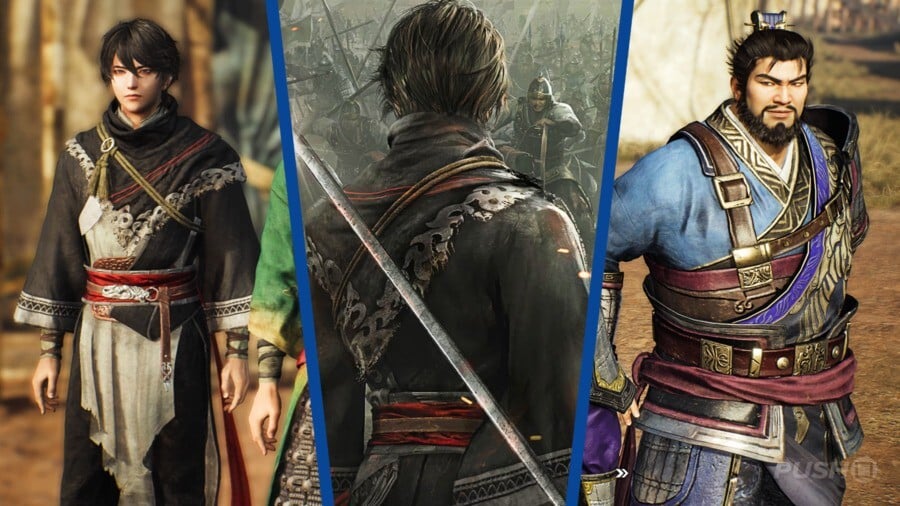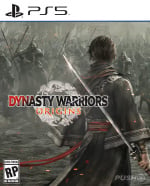Sho, the current head of Omega Force and producer of next year’s PS5 series reboot, has been working on the franchise since Dynasty Warriors 2 . Feeling the pull to try something new, he directed a handful of Musou adaptations, like Dragon Quest Heroes: The World Tree’s Woe and the Blight Below . Now he’s bringing all that he learned back to the main brand, in a release publisher Koei Tecmo is banking on revitalising the interest of core fans and attracting new ones.
From the Yellow Turban Rebellion through the Battle of Chibi, the distinctive larger-than-life battles that have defined Dynasty Warriors for the past two-and-a-bit decades remain largely unchanged here. But there’s a tactical edge to Origins which takes the series back to its roots; this is a game where you are a major player in the humongous skirmishes that occur around you, but you’re not the only one. You’re flanked by allies who will support you with the right assistance, and thus you need to plan accordingly.
Image: Koei Tecmo You’ll be able to test this out for yourself in a new demo available today , which plots the Battle of Sishui Gate, a significant chunk of the demo we got to play. This epic gauntlet sees you gradually working your way to the titular target, assisting your allies in order to open up pathways for reinforcements, eventually enabling you to overwhelm the enemy.
There’s a really unparalleled sense of scale here, and Sho believes it’s one of the biggest evolutions made possible through the power of the PS5.
“We really wanted to make sure we made the most of the PS5’s technical capabilities,” he tells us. “We settled on making you feel like you’re part of a realistic battlefield. That's been one of the goals of the series since its inception. We achieve that by not only having a huge number of troops on the field, but also the ability to control them and give them commands.”
While we certainly wouldn’t describe this as a strategy game, there are tactical elements that add meaningful depth to the button bashing. We were surprised, for example, to find our avant-garde approach to the aforementioned Battle of Sishui Gate ended in a premature Game Over screen, after we failed to support our allies appropriately and our army’s morale collapsed as a result.
One neat feature in this game is the ability to restart battles at key moments; some of these skirmishes can take close to an hour, after all. So rather than reboot the whole thing when you make a mistake, you can actually rewind to certain moments and explore different decisions; should you have flanked your foe instead of facing them head-on? Now you can explore that possibility.
The core combat itself is of course still extremely satisfying, with hundreds of troops getting dispatched like detritus in one rapid swoop. But the developer has taken the opportunity with this reboot to dial things down compared to previous games, which had almost 100 different characters and weapons. Instead, there’s just nine primary weapon types in this title, which Sho believes facilitates a more unique experience.
“Even though we’ve reduced the number of weapons, it’s allowed us to make each type more unique,” Sho explains. “So players will have a deeper understanding of the mechanics of each of the weapons. The growth of the protagonist is tied to the weapons he uses, so we hope players will give them all a try.”
We faffed around with Swords, Guandaos, Pudaos, and Wheels, all of which felt distinctive – a direct result of Sho’s real-life martial arts practice. More importantly, each one is tied to its own skill tree which builds the protagonist’s abilities in a different way, giving you that added incentive to explore them all, rather than settle upon the first one you find a liking to.
Our demo was conducted in the basement of the swanky Napoleon hotel, just a stone's throw away from the Arc de Triomphe — Images: Push Square It’s important to note that one of Origins’ big changes is its focus on a singular protagonist, as opposed to the swathes of heroes featured in past games. While there are opportunities to temporarily assume control of some of the legendary commanders from previous releases, this is a much more focused experience overall. The benefit this enables is the sense of progression you gain through the prism of that individual hero as a result.
Speaking of the protagonist, the game does succumb to the age-old anime amnesiac cliché. Sho says that working with other creators on collaboration games has given him an appreciation for storytelling and it’s one of the main improvements he’s bringing to Origins. However, the English dub is dismal, and we were excited to learn the Western release will also offer Japanese and Mandarin voiceovers out of the box. It may be tough paying attention to commands during combat with these languages enabled, but we’re confident it’ll improve upon the overall sense of immersion.
And that sense of place promises to be second-to-none thanks to Sho’s own personal dedication to the material. “I've been a fan of the [Japanese manga series] Sangokushi since it was released in 1971, [which is based on Romance of the Three Kingdoms],” he says. “I’ve studied all the research of various people. I’ve been to China five or six times. So I think I know everything I need to know about Romance of the Three Kingdoms.”
With this reboot, the team’s aim was to take all of that knowledge and repackage the historic story in a way that delves deeper than past entries, and engages both veteran fans of the franchise and newcomers alike.
While the story didn’t necessarily draw us in during our demo, we really enjoyed the structure of the game. You can move between different points of interest on the world map similar to a classic JRPG such as Dragon Quest , taking on small scale skirmishes to prepare yourself for big ones. There are also inns you can rest at, where you can use resources and currency to upgrade your weapons and purchase skills, as well as form bonds with allies you’ve recruited to work alongside you.
There’s a real sense of adventure and progression, both at the macro scale of the campaign as a whole, and within individual battles. The aforementioned Battle of Sishui Gate transitions from a struggle to a rout once you adopt the right strategy, for example – but also your own abilities become so much more capable once you’ve acquired the right resources and invested them appropriately. We suspect this sense of continual growth will be a key draw of the final product.
As we wrap up our demo and ready ourselves to brave the harsh Parisian weather once more, it feels appropriate that the city is dressed in Gladiator 2 promotional materials, having enjoyed its premiere days prior to our preview.
“Gladiator is one of the movies that I've taken inspiration from,” Sho admits. “In that film, you see it’s not everyone charging at once or everyone battling at once. Sometimes on the battlefields, there are some that may not be as intensely fighting or maybe even slacking off. So having that variety of personality or people on the field is something I drew inspiration from.”
From our time playing Dynasty Warriors: Origins, that aspect is obvious. This is still a power fantasy designed for people wanting to let off steam by pummelling hundreds and hundreds of troops on screen. But it feels like you’re part of something bigger – a sprawling battlefield occupied by allies and enemies, each with personalities and objectives.
It’s that aspect, along with the constant sense of progression, which we suspect will make this series reboot stand out – and Sho’s unparalleled commitment to his craft all the more meaningful.
Thank you to Koei Tecmo for giving us the opportunity to play Dynasty Warriors: Origins early and chat with producer Tomohiko Sho. Will you be testing out the game’s demo ahead of its 17th January release? Swarm all opposing armies in the comments section below.






